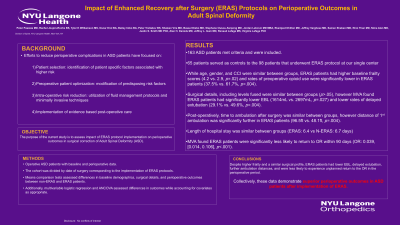Impact of Enhanced Recovery after Surgery (ERAS) Protocols on Perioperative Outcomes in Adult Spinal Deformity
Impact of Enhanced Recovery After Surgery (ERAS) Protocols on Perioperative Outcomes in Adult Spinal Deformity
Friday, April 21, 2023


Peter G. Passias, MD
Spine Surgeon
NYU School of Medicine
New Canaan, CT, US
ePoster Presenter(s)
Introduction: ERAS protocols are multifaceted programs with preoperative, intraoperative, and postoperative components that have been shown to improve surgical outcomes. This study assesses impact of ERAS protocols on perioperative outcomes in surgical correction of Adult Spinal Deformity(ASD).
Methods: Retrospective cohort study of a singl-center ASD database. Patients ≥18 years old with baseline(BL) and perioperative(Peri-Op) data were included. The cohort was divided by date of surgery corresponding to the implementation of ERAS protocols. Univariate and multivariate analyses assessed differences in baseline demographics, surgical details, and perioperative outcomes between non-ERAS and ERAS patients.
Results: 163 patients met inclusion, (65 non-ERAS; 98 ERAS). While age, gender, and CCI were similar between groups, ERAS patients had higher baseline frailty (4.2 vs. 2.9, p=.02) and lower rates of preoperative opioid use (37.5% vs. 61.7%, p=.004). Surgical details, including levels fused were similar between groups(p>.05), however MVA found ERAS patients had significantly lower EBL(1614mL vs. 2697mL, p=.027) and lower rates of delayed extubation(29.1% vs. 49.6%, p=.004). Post-operatively, time to ambulation after surgery was similar between groups, however distance of 1st ambulation was significantly further in ERAS patients(96.5ft vs. 48.1ft, p=.004). LOS was similar between groups(ERAS: 6.4 vs N-ERAS: 6.7 days), yet MVA found ERAS patients were significantly less likely to return to OR within 90 days(OR: 0.039, [0.014, 0.106], p < .001).
Conclusion : This study assessed impact of institutional implementation of an ERAS protocol on perioperative outcomes in adult spinal deformity. Despite higher frailty and a similar surgical profile, ERAS patients had lower EBL, lower rates of delayed extubation and further ambulation distances post-operatively. Moreover, ERAS patients were significantly less likely to experience unplanned return to the OR in the perioperative period. Collectively, these data demonstrate superior perioperative outcomes in ASD patients after implementation of ERAS.
Methods: Retrospective cohort study of a singl-center ASD database. Patients ≥18 years old with baseline(BL) and perioperative(Peri-Op) data were included. The cohort was divided by date of surgery corresponding to the implementation of ERAS protocols. Univariate and multivariate analyses assessed differences in baseline demographics, surgical details, and perioperative outcomes between non-ERAS and ERAS patients.
Results: 163 patients met inclusion, (65 non-ERAS; 98 ERAS). While age, gender, and CCI were similar between groups, ERAS patients had higher baseline frailty (4.2 vs. 2.9, p=.02) and lower rates of preoperative opioid use (37.5% vs. 61.7%, p=.004). Surgical details, including levels fused were similar between groups(p>.05), however MVA found ERAS patients had significantly lower EBL(1614mL vs. 2697mL, p=.027) and lower rates of delayed extubation(29.1% vs. 49.6%, p=.004). Post-operatively, time to ambulation after surgery was similar between groups, however distance of 1st ambulation was significantly further in ERAS patients(96.5ft vs. 48.1ft, p=.004). LOS was similar between groups(ERAS: 6.4 vs N-ERAS: 6.7 days), yet MVA found ERAS patients were significantly less likely to return to OR within 90 days(OR: 0.039, [0.014, 0.106], p < .001).
Conclusion : This study assessed impact of institutional implementation of an ERAS protocol on perioperative outcomes in adult spinal deformity. Despite higher frailty and a similar surgical profile, ERAS patients had lower EBL, lower rates of delayed extubation and further ambulation distances post-operatively. Moreover, ERAS patients were significantly less likely to experience unplanned return to the OR in the perioperative period. Collectively, these data demonstrate superior perioperative outcomes in ASD patients after implementation of ERAS.
